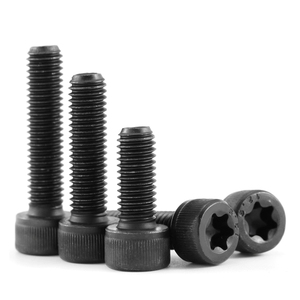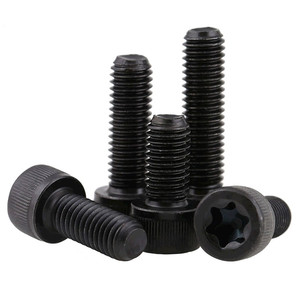
All categories
Featured selections
Trade Assurance
Buyer Central
Help Center
Get the app
Become a supplier

(617 products available)




















































Engineers classify bolts into various types based on design differences and features like thread pitch, overall shape and length, materials, strength grades, coatings, and how people utilize them.
M13 X 70 Flange Bolt
A 70 mm M13 X 70 flange bolt is a medium-length bolt that securely binds machine components where shorter bolts cannot reach. Due to its non-rotating, wider-load distributing flange, it is ideal for heavy-duty applications that require additional thread engagement for strength.
M13 X 80 Flange Bolt
The M13 X 80 flange bolt, with an 80 mm length and 13 mm diameter, offers reliable performance in medium to heavy loads. The extra length provides greater grip without compromising the bolt's structural integrity, making it suitable for various engineering and construction tasks.
M13 X 90 Flange Bolt
The M13 X 90 flange bolt has a length of 90 mm, making it suitable for applications that need resistance to shear forces and vibration loosening. The bolt's body has precise threads that ensure a secure fit in critical machinery.
M13 X 100 Flange Bolt
An M13 X 100 flange bolt has an overall length of approximately 100 mm and a diameter of 13 millimeters. It is made of stainless steel for corrosion resistance in outdoor settings. This bolt is often used in the automotive and construction industries.
M13 X 110 Flange Bolt
The M13 X 110 flange bolt, with a length of 110 mm, is employed in construction projects where a firm grip is necessary for joining metal beams and concrete. The additional length provides more threading, ensuring enduring stability in demanding environments.
Flange bolts perform specific functions across various industrial applications. They are characterized by a wide, flat, and sometimes riveted bearing surface underneath the bolt head. These surfaces allow even weight distribution across the mounted material, which helps:
Secure Components
Engineers use flange bolts to securely bind machinery and structural components. The large bearing surfaces on the bolt heads let flange bolts distribute loads evenly.
Improve Load Distribution
The bolt's flanged head spreads the load across a broader area compared to standard bolts. This reduces the likelihood of the surrounding material deforming or cracking under stress.
Vibration Resistance
In industries like automotive and aerospace, where machines generate significant vibrations, flange bolts are vital. The way these bolts grip and use their wider surfaces helps them withstand vibration-induced loosening.
Alignment of Components
Flange bolts are employed in machinery and structural frameworks to maintain precise alignment of different components. Their design centrally positions the threaded shaft concerning the bolt head.
Joining Dissimilar Materials
Flange bolts allow joining materials with different properties, such as metal and plastic. Their elongated design and special surfaces facilitate secure fittings, even with variations in expansion rates between materials.
An M13 flange bolt has multiple distinguishing features that set it apart from other bolts. The most important features of this bolt are the following:
Integrated Flange
M13 flange bolts have a distinct flange feature that sets them apart from traditional counterparts. Positioned beneath the head, the flange resembles a wide, flat plate or disc integrated into the bolt. This unique design feature provides a larger surface area compared to standard bolt heads.
Thread Specifications
The M13 bolts have metric threads with a pitch normally found in mechanical applications. This threading style is crucial for ensuring proper engagement with corresponding nut or threaded hole instances, providing a secure fit.
Material Composition
Suppliers usually forge flange bolts from durable steel alloys that balance tensile strength, flexibility, and resistance to different degradation forms. Some variants may undergo heat treatment processes to enhance hardness and durability further.
Coating Options
Coating plays an important role in flange feature integrity. To safeguard against rust, corrosion, and wear, these bolts frequently undergo application processes such as galvanization, black oxide, or powder coating. Such protective layers are paramount, especially for teams handling construction projects who must operate in challenging outdoor environments.
Flange Bolts Aesthetic Appeal
Beyond their functional advantages, the wide, flat design of flange head bolts lends an aesthetic quality. These bolts give a polished, contemporary view to assembled components, which can be vital for exposed machinery in design-centric industries.
An M13 flange bolt's thoughtful design enhances its functionality, enabling it to perform crucial roles in securing components across industries.
Flanged Head
The most distinguishing feature of flange bolts is their flanged head. Unlike regular bolts with a rounded or squared head, the flange bolts incorporate a wide, flat surface beneath the head, resembling a disc or plate. This flange spreads the load across a broader area compared to standard bolt heads. It reduces the risk of damaging the surrounding material due to heavy tension.
Tread Profile
The M13 flange bolt has metric threads since it's an M13 bolt. Metric threads are typically characterized by a pitch distance that determines the thread's height and spacing. This specific tread profile ensures the bolt securely fits corresponding components, like nuts or threaded holes.
Material Selection
Flange bolt sets usually have fabrication from quality steel alloys intended for strength and durability inside challenging environments. Some of these bolts have coatings like zinc for corrosion retardation. Other variants may have heat-treated components which increase the hardness of the flange bolt, making it tough to snap under immense tension.
Length and Diameter
M13 flange bolts come in different lengths and diameters to meet other needs. As the diameter increases, the tensile strength proportionately increases. Meanwhile, varied lengths provide functional range, accommodating distinct thicknesses of joined materials.
Socket For Supplying Power
To facilitate installation and removal using specific tools like torque wrenches, the flange bolts have socket interiors. This feature promotes even load distribution when tightening, improving assembly integrity.
The versatile M13 flange bolt has many uses across diverse industries because of its unique construction characteristics.
Automotive Assembly
The automotive sector uses the M13 bolt kit to secure engine components, exhaust systems, and suspension parts. The bolt's broader load distribution reduces vibration-induced loosening, which is vital for achieving safety and performance in automobiles.
Building Frameworks
Engineers utilize the M13 flange bolt to build steel frames for commercial and residential buildings. The flange provides the required support by spreading the load over larger areas. This trait enhances the stability and longevity of structures during challenging weather conditions.
Heavy Machinery
In industries dealing with heavy machinery, they have come to value the M13 flange bolt as an important component in assembling vital parts like gearboxes and drive shafts. The design allows it to sustain significant loads without experiencing deformation or failure.
Railway Track Installation
Workers use flange bolts within railway systems for track installation. Their resistance to dynamic loads and movements caused by passing trains makes them ideal for maintaining alignment and ensuring the rails stay securely fastened over time.
Industrial Equipment
The suppliers use the M13 hex bolts and nut combination in industrial equipment assembly, such as compressors and generators. The flange helps distribute pressure in high-stress areas. This characteristic enhances equipment reliability in industrial settings.
Proper Length
Select the flange bolt with the correct length for the joint being secured. The bolt should go through the materials completely and have enough thread for a nut or threaded hole. Avoid choosing a long bolt lest it extend beyond the materials and pose safety risks. Also, avoid short bolts as they won't provide enough engagement, causing weak connections.
Correct Diameter
Choose the proper diameter size of the flange bolt to securely fasten the materials and share the tension load across a wider area. A diameter suitable for the application helps avoid crushing or splitting wood, plastic, and metal. On the other hand, a diameter that is too small for the task will continue risking bolt failure from either snapping or pulling out.
Tread Type
Bolts usually come with coarse and fine metric tread types. Coarse treads make it fast to secure large components, while they also allow much easier alignment. In addition, fine treads provide a tighter fit for high-precision parts. Choose a tread type that fits the material and workload for better fastening.
Material and Coating
Flange screws typically have construction from steel alloys that provide strength. Many have undergone galvanization or come with other protective coatings for fastenings used in outdoor environments. Such coatings resist rust and corrosion, preserving the bolt's integrity over time. Select a material and coating that meet the required durability needs of the environment where the user will use them.
Strength Rating
The strength ratings of the bolts, such as the yield and ultimate tensile strengths, will determine the maximum tension the bolt can bear without permanent deformation. For securing heavy loads or structural components, choosing high-strength hexagon bolts and flange nuts is best. However, for lighter tasks, lower-rated bolts will suffice.
A1: Flange bolts are fasteners with a wide, flat bearing surface, often a flange, below the head. This unique design spreads the load across a larger area. However, regular bolts have rounded or squared heads without this feature.
A2: The M13 flange screw has a wider load distribution because of its threaded flange head. This characteristic reduces the risk of component damage due to tension. It also comes with resistance to vibration-induced loosening, making it suited to heavy-duty tasks.
A3: Steel alloy M13 flange screws provide excellent durability. They do not bend and are resistant to breaking under immense pressure. Some variants feature protective coatings like zinc to enhance corrosion resistance, reducing wear and extending longevity.
A4: The automotive sector uses M13 flange bolts to assemble engine and suspension parts. Construction industries employ them for building frameworks. They are also commonly found in machinery, rail installations, and other industrial equipment.
A5: The flanged head of flanged bolts increases contact with the mounted surface. This design minimizes the chance of loosening while evenly distributing tension. It allows greater torque during installation without causing material deformation.